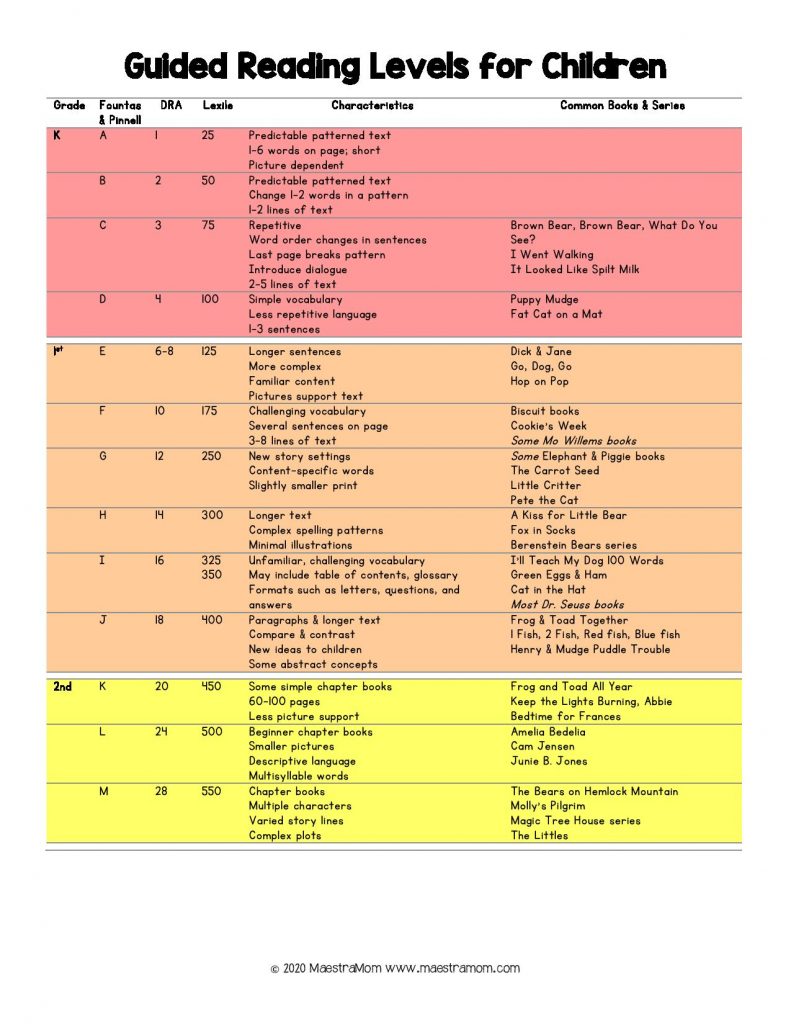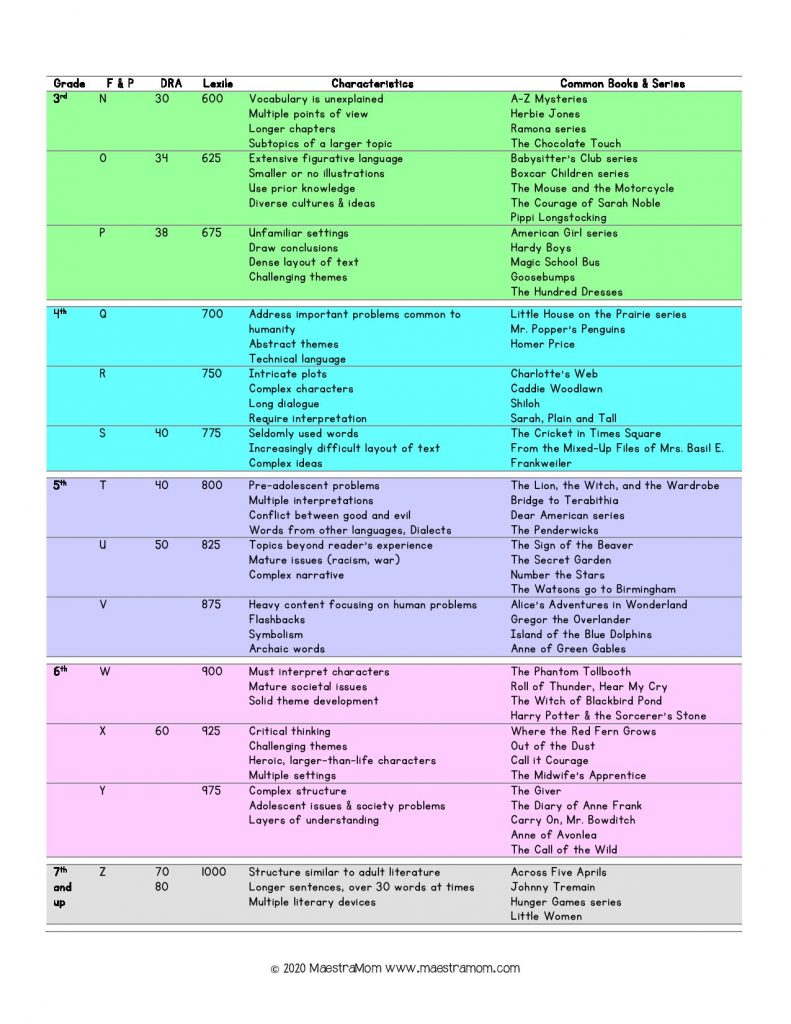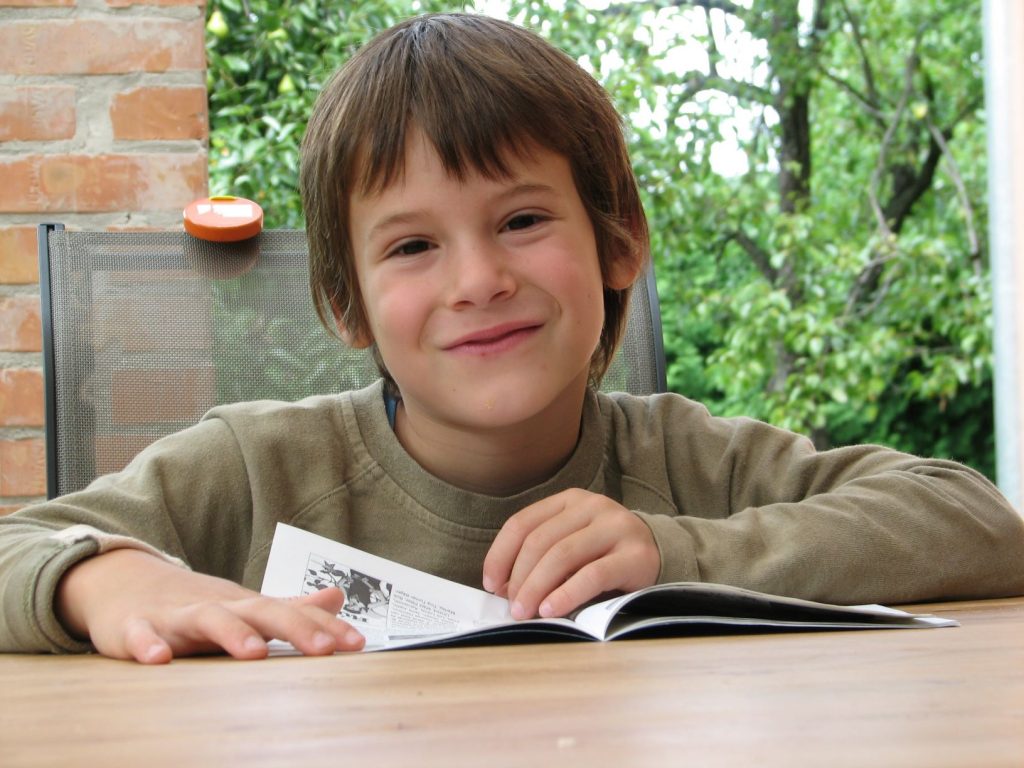As parents, we definitely want to get fabulous reading level appropriate literature into our kids’ hands, but there are so many systems with various numbers and letters on them that it is a challenge to make sense of it all! I know what size pants to buy for my kids, but how am I supposed to know my child’s reading level?
If your child goes to a brick-and-mortar school, teachers often assess students’ reading levels several times each school year, often at the beginning, middle, and end of the school year. But, even if the teacher sends home a report with a letter or number reading level, how do you make sense of it?
For homeschool students, it can be even trickier. Without access to the assessments used in public schools, it can be difficult to ascertain a child’s exact reading level and so parents may be completely unaware of their child’s reading level.

Reading Levels Explained
First, it’s important to know that there are several well-known systems of reading levels. While these often correlate, they are measured independently depending on the assessment.
Most reading levels are represented with a letter A to Z (the Fountas & Pinnell system) or a number 1 to 80 (the DRA system). Other systems including Rigby, Scholastic Guided Reading Levels and Reading A-Z are usually very similar to these two biggies. So, for example, your child’s teacher may send home a progress report saying your child is reading on level J or J/18, which is a combination of the two main systems.
Additionally, some assessments provide a Lexile reading level, which is a number between 25-1000. Lexile numbers are represented with a letter L after the number. For example, 450L. These numbers are assigned to books to show the reading difficulty level and also used to benchmark a child’s reading ability.
Confused yet? Don’t worry! I made a simple chart to make it understandable. Print a copy or pin it to Pinterest to keep it handy. The chart breaks down reading levels by grade and correlates Fountas & Pinnell, DRA, and Lexile levels. It also explains in plain English what types of text you see at each level and lists common familiar books.
Read: 10 Children’s Books About Diversity


Reading Level by Grade
Kids grow! They grow in reading just like they do in shoe size. What do I mean? Well, just as most kids in kindergarten are about the same height and wear a similar shoe size, most of them will also share similar reading levels. However, you know how there’s always the one really tall kid? There’s usually one way ahead in reading, too, and maybe one who is way behind.
When you see a reading level chart, don’t get too concerned if your child is one or two letters ahead or behind their grade level. That’s pretty normal! The important thing is to make sure your child is progressing! Normally, there’s a wide variety of levels within each grade.
Just like you purchase new clothes and new shoes in a larger size when your child outgrows the old ones, you need to make sure you know your kid’s reading level so you can providing new books for your kids based on their current reading level. Watch out! This will change about as frequently as they need a new pair of shoes!
In general, these are the common reading levels by grade:
- Kindergarten: levels A-D
- 1st grade: levels E-J
- 2nd grade: levels K-M
- 3rd grade: levels N-P
- 4th grade: levels Q-S
- 5th grade: levels T-V
- 6th grade: levels W-Y
- 7th grade: level Z

Reading Level: A Couple of Important Things to Notice
Way to go, 1st grade!
First, you may have noticed that there are a LOT of levels on the reading level chart covered in 1st grade! That’s the “heavy-lifting” year with the most variety in student’s reading levels. This is the reason why you meet some 1st graders who can barely read and others who are quite fluent with text. Totally normal both ways! A student is not really required to be reading independently until the end of 1st grade.
There’s Still Time
Second, did you see how the reading levels stop in 7th grade? While the texts do get more difficult afterwards and touch on more mature topics, after junior high the reading levels even out. This is GREAT news! It means that if your child is behind and needs a few more years to work through that progression, it is no big deal! They may seem behind in elementary years, but will catch up with peers in the junior high and high school years with few adverse consequences! Yay! So don’t stress too much about your child’s reading level.
Read: Could it be Dyslexia? An Interview with a Dyslexia Specialist
Differing Opinions
Third, not all authorities agree completely on the leveling of books, That’s why you may see Magic Tree House listed as level L on one reading level chart, level M on another, and level N on yet another. Often times there can be variation within a series as well. But, if suggested reading levels are slightly off, it is ok because it never hurts a child to read literature too easy for them just for fun! In facts, kids frequently fall in love with reading when they can dive into easy books that are of great interest to them. When in doubt, err on the side of a book that is too easy.
Read: Phonics in Preschool and Kindergarten

How to Determine Your Child’s Reading Level
You can figure out your child’s reading level at home yourself with a casual assessment called a running record. You can do a running record on any book with any child in about 10 minutes! Elementary school teachers frequently use them to spot-check student progress quickly throughout the year. It is not difficult to learn how to do a running record but it is immensely helpful to pinpoint your child’s reading level so you can get the right books into his hands.
How do you Know a Book’s Reading Level?
There are many book companies out there that label their books as beginning readers or use numbers such as levels 1, 2, 3, 4, but these often do not correspond to the guided reading levels that teacher’s use in the Fountas & Pinnell or DRA system. Yikes.
To add to the confusion, most beginning reader’s books are actually geared towards slightly older children and are often much too difficult for true kindergarten beginning readers. I found this amazing Easy Reader chart where the author demystifies the reading levels for popular series such as Hello Readers and Ready-to-Read.
But don’t give up yet! Figuring out a book’s level is actually pretty easy! For most books, you can simply type into a Google search something like “reading level for [Title of Book]” and it will come back with the DRA number or Fountas & Pinnell letter.
Another resource I love is the Book Wizard App by Scholastic. With this handy app, you scan a book’s bar-code with your phone and it immediately tells you the DRA, Fountas & Pinnell, Lexile, and grade level. Thank you, Scholastic! Just what we needed!
Several years ago, over a few summer days, I sat with my Book Wizard and a huge pile of all of our children’s books. I scanned each one and wrote the reading level letter inside the front cover.
Then, I placed the books into piles and grouped books of the same reading level into plastic bags so I would have leveled books whenever needed. Now, it is super easy to grab all my letter D’s or H’s whenever we’re ready for them!
Read: Top 10 Social Emotional Picture Books for Kids

Fall in Love with a Good Book
So, there you have it! No more confusion! Just like you know your child’s shoe size and clothing size, now you can figure out their reading level as well! Every child deserves some “just right” quality literature to help them fall in love with reading!
Leave me a comment below: do you know your kids reading level?
RELATED POSTS:
- 1st Grade Books List
- 2nd Grade Books List
- 3rd Grade Books List
- 4th Grade Books List
- 5th Grade Books List



Pingback: What is a Running Record & Why You Should Use It - Maestra Mom
Great explanations for discovering reading levels for kids. Thanks for sharing! I remember researching this on my own years ago when my kids were younger.
Thanks, Kendra! That’s awesome that you took the time to figure it out when your kids were young!
This is a fantastic post! It’s so important to know your child’s level of reading, and this table is very helpful! Thank you so much!
Thank you, Holly! I appreciate those kind words!
I’ve always seen the letters from teachers but never really elaborated as they were where they needed to be or above. This is a great way to understand. I love the suggestions you give according to each level!
Adrienne, I’m so happy to hear this was illuminating for you! Next time that info comes home, you will be good to go!
This is helpful information. It’s sometimes hard to figure out what reading level a specific book is and whether it would be too hard to read or just the right level.
Bonnie, that is true! If you know your child’s reading level, now you can quickly figure out a book’s level too and find the perfect match!
Great resource! Especially now with Covid! And as a teacher of new readers I would have loved if parents would have been more involved and knew.
Hi Karie! Yes, I agree! The best learning occurs when parents and teachers can work together to help kids succeed!
Thanks for the explanation. I never really understood how reading levels were determined.
Yay! So glad you now have the knowledge you need!
Sabrina, you are welcome! Reading levels are one of those things we tend to leave to teachers, but isn’t it nice to know all about it?
This is such helpful information! I had no idea how to figure this out. Thank you!
I’m so glad it was helpful!
Thank you for this! My daughter is always coming home with different numbers and letters and this is helpful to figure out what books fit her level.
Now you’re all set to understand all those letters and numbers! I’m thrilled this was helpful!
Very interesting info!
Ou school is great about sharing this information with us 2x a year – reading levels sure do very. Between our twins it is so different and can change midyear so it is good to keep track. Great post.
This is really great information. I hope to have my little guy reading by the end of the year. He can read two letter words and a few three letter words but that is it so far.